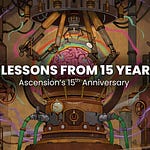About Kohji
Kohji Nagata has worn many hats—software developer, musician, podcast creator—but today he’s best known as Head of Design and co-founder of Parallel Studios, where he helped launch the massively successful Web3 trading card game Parallel. What started as a passion project has become a genre-defining phenomenon, valued at one point at half a billion dollars. Kohji approaches design from a deep philosophical place, wrestling with fear of failure, perfectionism, and the drive to always improve. In this episode, he and Justin explore the creative tension between success and self-doubt, dissect the mechanics of resource systems in TCGs, and dig into the role of AI in the future of game design. Whether you're an aspiring creator or a veteran designer, this conversation offers a rare window into the mind of someone building at the frontier of games and technology.
Ah-ha! Justin’s Takeaways
Good times aren’t good times forever. Kohji shares why success can be dangerous if you’re not prepared for change. One of his core lessons in running a game company: always know your runway. Ask yourself, “If no more money came in starting today, how long could we operate?” That’s not just a financial question—it’s an emotional one. Kohji urges creators to forecast a wide range of outcomes, be brutally honest with themselves, and prepare their business to weather the unexpected.
The Digital Glass Case: Kohji explains that Parallel's early success wasn’t just about game mechanics, it was about making collecting feel magical. From cinematic pack opening sequences to rare cards that feel like treasures, Kohji and his team recreated the feeling of standing at a store counter, flipping through Scry magazine, and dreaming of pulling a Black Lotus. If you’re working on a digital game, investing in how players open, view, and share their digital objects is just as important as the gameplay itself.
Make Them Care, Then Put Them in Danger: When designing Colony, Kohji realized that what makes a game stick isn’t always the loop, it’s the character attachment. His goal? Make you fall in love with a character, then throw them into peril. Whether you're building an AI-driven game or writing a campaign, Kohji challenges creators to increase emotional investment. Want players to care deeply? Build better characters and raise the stakes.
Show Notes
“I look at the games that I make and the only thing I see is all the mistakes or all the things I want to improve.” (00:04:03)
Kohji Nagata shares how a strong work ethic and a deep-seated drive for quality shaped his journey from musician and developer to game designer and co-founder of Parallel Studios. His early lessons, instilled by parents who emphasized hard work and focus the best version of things, sparked a philosophy that now defines his design work: always push for better.
“I took all the elements of the card games I love and smashed them together.” (00:19:42)
Kohji explains how Parallel blends the strategic depth of Magic: The Gathering, the streamlined resource system of Hearthstone, and a unique banking mechanic that adds player choice and tension to every turn. The result is a game that feels fast and competitive without sacrificing tactical nuance. If you’re a TCG fan or designer, this section offers a clear look at how thoughtful fusion—not just innovation—can create something truly new.
“We were like, we don't have a fun game yet. So we need to give people a fun experience.” (00:40:26)
That insight led to one of Parallel’s most beloved innovations: a cinematic card pack opening that made collecting digital cards feel exciting, tangible, and memorable. Kohji breaks down how Parallel didn’t just lean into Web3 for ownership’s sake, it used the technology to make collecting feel like collecting. Whether you’re a designer, developer, or creative of any kind, this moment underscores a lesson I’ve repeated across nearly every episode: in game design, the most important metric is player experience.













